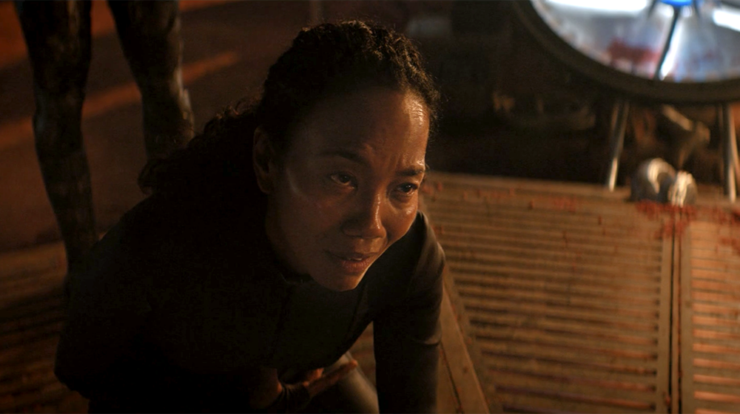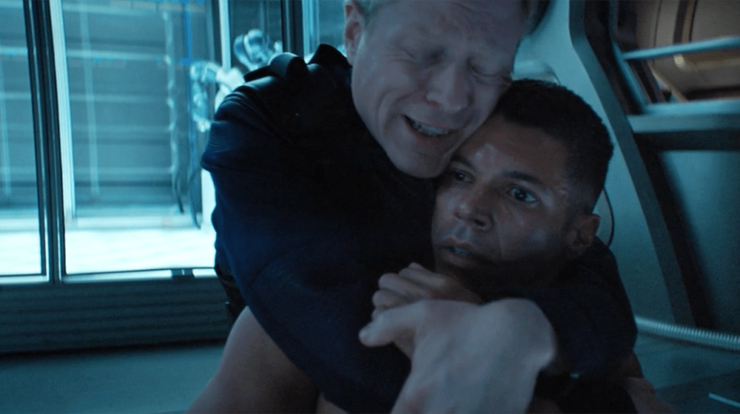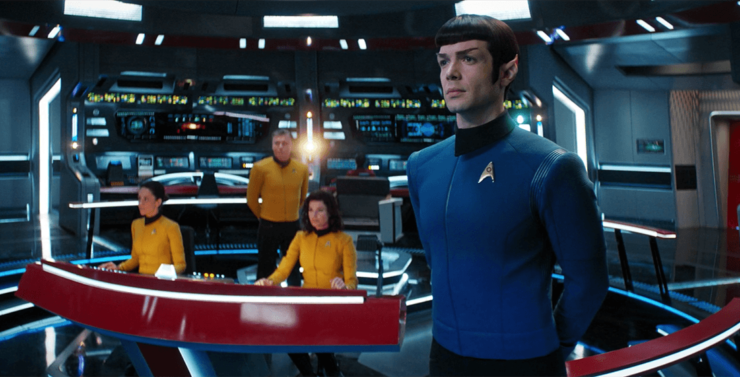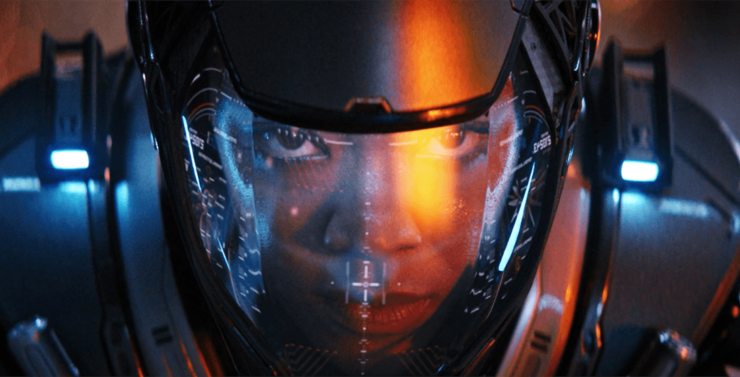Throughout the first season of Star Trek: Discovery, there was some obvious tension between the show that Bryan Fuller originally envisioned, and the one that was actually developed by his successors, Gretchen J. Berg & Aaron Harberts, after he and the show parted ways.
This was not always a smooth process, and Berg & Harberts seemed determined in season two to correct many of the issues with season one.
But then Berg & Harberts and the show parted ways, and their successors were faced with a similar dilemma.
One of the interesting tropes that’s coming out of Discovery is that, while the captain isn’t the main character on the show, it’s dealing quite aggressively with the notion that the captain sets the tone for the ship.
We’ve had three different people in command of the U.S.S. Discovery over two seasons, and each has set a very specific tone. For much of season one it was Gabriel Lorca—or, more accurately, Lorca’s evil twin Skippy, bringing some Terran Empire-inspired awfulness. His Discovery was grim and dark and unpleasant, not aided by the fact that they were fighting a war.
Once Lorca’s mendacity was uncovered, Saru was made acting captain, and Discovery became what it was described as when we first saw it in “Context is for Kings“: a vessel of science and exploration.
Probably the best illustration of the difference between the two is that on Lorca’s ship, nobody would sit with Burnham in the mess hall, but on Saru’s ship, people moved to sit with Tyler/Voq. Instead of a predator, the ship was led by prey; instead of attacking, the leader was now one who accommodates.
Then this year we got a detour, as the ship was given a temporary captain in Christopher Pike, and he set a tone of his own. Right from jump, he wants to know everyone’s name. I said in my review of “Such Sweet Sorrow, Part 2” that Anson Mount’s performance has his emotions etched on his features, and that too set the tone for the series. This is a very emotional season, from small things like Tilly dealing with command training and Georgiou poking the crew with a stick to big things like Culber coming back from the dead, Airiam’s death, and Burnham’s reunion with her mother.

But while the character work has remained strong, the story is a bit of a mess. The season started out with a powerful angelic creature—actually called an angel—that rescued humans from destruction in the midst of World War III, that rescued Burnham as a child, that gave messages to Spock, and that sent seven signals. It seemed as if the show was going to deal with a powerful being that had some kind of divine background—or at least pretended to.
In the past when Trek has dealt with religion and spirituality, it’s always had a basis observable phenomena. The Greek gods were actually powerful aliens; so are the Bajoran Prophets. The Klingon Messiah is a historical figure—they’ve even got a blood sample!
This is the route they took eventually with the red angel, but it all feels uneven. We find out the red angel is, in fact, a time-distorted view of Gabrielle Burnham, wearing a suit designed decades earlier by Section 31. The ability of the suit to travel through time adequately explains how it’s been so many places, but it does very little to explain how Gabrielle accomplished her rather Herculean tasks—or, for that matter, how red angel version 2.0 (Burnham in the finale) was able to send the signals. The suit’s capabilities are basically “what the plot requires,” and there isn’t even an attempt to explain how one woman in a fancy suit can move an entire village across 51,000 light-years to another planet in “New Eden.”
In general, Section 31 is the worst kind of writers crutch, exactly the thing I feared it would become two decades ago when the organization was introduced. They’re a lazy boogeyman, here to allow our heroes to not be heroic and have cover for it, thus subverting the whole point of the franchise’s optimistic future. Plus, as I said about 31 back in my rewatch of “Inter Arma Enim Silent Leges,” there are few things in this world less interesting than the all-powerful organization that can’t be stopped. Here, they have absurd amounts of technology (including a 24th-century combadge) and seem to be unstoppable in a manner that is most tiresome. And then it’s their AI that turns out to be the big bad, crowbarred into the plot to give them someone to fight.
But where the season falls down in terms of plot, it shines in two other ways. One is the characterization, which has always been what’s kept even the worst of Star Trek going. (As an example, it’s pretty much all that made the Bad Robot films bearable.) The bridge crew starts to get some depth, particularly the front-of-the-ship duo of Owosekun and Detmer. We get the magnificent addition of Tig Notaro’s Jett Reno, who sounds like most of the engineers I’ve met in real life, and whose acid commentary is welcome.

The most offensive feature of season one is reversed with some mycelial-network handwaving, as Culber is brought back from the dead. The transition back to the real world is not an easy one, and I wish they had devoted some more time to what he was dealing with. One informal therapy session with Admiral Cornwell seems inadequate. Still, Wilson Cruz and Anthony Rapp beautifully play the characters’ anguish, with Rapp in particular selling how helpless Stamets feels when he tries and fails to re-create their lives together after his return.
Having said that, the only truly missed opportunity was not doing more with Culber’s response to Tyler beyond the abortive mess-hall fight. Just in general, Tyler is one part of the season that sticks out like a sore thumb. His romance with Burnham is lifeless—Shazad Latif and Sonequa Martin-Green have no chemistry whatsoever—and aside from that mess-hall scene, we get no sense of how the rest of the crew feels about Culber’s murderer being assigned to the ship. This is mostly accomplished by keeping him away from the rest of the crew—Tyler’s interactions are all with Pike (who wasn’t on the ship last year), Georgiou (who sees him being a murderer as a feature, not a bug), Leland (ditto), and L’Rell (who was the one who sent him to commit that murder in the first place). And Burnham, but they spend all their time making sodden goo-goo eyes at each other.
Saru’s development is going to be particularly interesting to watch, especially since he’s the senior-most person left on the ship as it bounces into the future at the end of the season, which means we’re probably back to having the Kelpien in charge. But this season we also found out that his people aren’t prey animals permanently, it’s just their caterpillar stage, and their oppressors, the Ba’ul, killed them before they could become butterflies. But Saru is now more assertive, more aggressive, and less passive. It’s gonna be interesting to see how the analytical officer is going to deal with this new personality next season.
But the most fun this season was the embracing its prequelness. While the first season took stabs at it—particularly with the brilliant retcon in “Lethe” regarding what Sarek gave up to secure a spot for Spock at Vulcan Space School—this season embraced it wholeheartedly. The most glorious example, of course, was the “previously on” segment at the top of “If Memory Serves,” which was entirely footage from “The Cage,” with the episode itself serving as the first of two bridges between that failed pilot and the framing sequence of “The Menagerie.” But just in general, so much this season added texture to the events of both those original series episodes, from showing the depth of Pike and Spock’s comradeship to Pike learning of his fate on the cadet ship and still plowing ahead. (I would’ve liked this season’s events to have gone some way toward explaining why going to Talos IV was a death-penalty offense in “The Menagerie,” but it was not to be. A pity, as that was one of Gene Roddenberry’s stupider plot points, and it would’ve been nice to have it retconned into something sensible.)

It took bloody well long enough for Ethan Peck to show up in any meaningful capacity as Spock, but when he did, he was superb. The revelation that he was dyslexic was a masterstroke, as the notion that the smartest person in the Star Trek universe has a learning disability is one of the most Trekkish things ever, exactly the sort of hopeful, positive message that is a hallmark of Trek at its best. And in general, Peck beautifully channeled a character that two people have already put their marks on and made it his own while, like Zachary Quinto before him, paying tribute to Leonard Nimoy’s superlative inhabiting of the character.
I must also give mad props to Rebecca Romijn, giving us a great sequel to Majel Barrett as Number One. (Oh, and I was wrong in my review of the finale, Pike did refer to Number One as “Una” at one point, which was the first name that the team of Greg Cox, David Mack, and Dayton Ward & Kevin Dilmore gave her in the Legacies trilogy of Star Trek novels in 2016, that name being a tribute to another of our fellow Trek novelists, Una McCormack. No doubt it was provided by yet another Trek novelist, Kirsten Beyer, who is the executive story editor on Discovery. It joins Sulu and Uhura‘s first names as things established in tie-in fiction that made it to the screen.) Honestly, the main reason why I want to see at least a miniseries with Mount, Peck, and Romijn as Pike, Spock, and Number One is her—we know what happens to the first two, but Number One’s an open book, and the glances we got of her plainspoken, can-do, no-fucks-to-give attitude is making me eager for more. Much more.
Perhaps my biggest frustration with the first season of the show was that the brief glance we got of the U.S.S. Shenzhou in “The Vulcan Hello” and “Battle at the Binary Stars” was actually a much more interesting and compelling shipboard dynamic than the nastier one we got for the rest of the season with Burnham disgraced and working for a disguised villain. This season, we got Burnham back as a high-ranking officer, and it’s wonderful to see her in a stronger position. In particular her interactions with Saru and Pike and especially Spock are some of the high points of the season. (Pretty much every scene that Martin-Green and Peck had together was worth the price of admission for the whole season, which makes the lengthy half-season Spock-tease before we saw him all the more frustrating.)
That all pales in comparison to the amazing work she does across from the great Sonja Sohn as Gabrielle. The devastation, the emotional roller coaster that Burnham goes on, learning that her mother is still alive—and worse, doesn’t want to talk to her—the pain she feels, the open wound that her parents’ (seeming) death left her with that gets salt poured on it… It’s just a bravura job by Martin-Green.

Mount has been the breakout character, and plenty has already been written by me and others about how brilliant he’s been this season, made especially more impressive by how incredibly horrible he was as Black Bolt in The Inhumans. But Martin-Green is still the star of the show, and her journey is quite impressive, for all that it’s in a plot that only sometimes makes sense.
Michelle Paradise—who wrote “Project Daedalus” and cowrote the two–part finale—will be taking over as show-runner next season, and let’s hope she makes it all the way through. It will be nice to get a stable season of Discovery, especially since this one is jumping ahead well beyond where anyone has gone before.
And, hey, they went to all the trouble to build that Enterprise set. Seems like a waste of good money to not do more with Pike and the gang…
Keith R.A. DeCandido is at Awesome Con in Washington, D.C. this weekend. Look for him at Bard’s Tower, Booth 1311, alongside many fellow authors, among them Kevin J. Anderson, R.R. Virdi, Charles E. Gannon, D.J. Butler, Quincy J. Allen, and tons more. Also at the con are Trek actors Jonathan Frakes, Greg Grunberg, Jason Isaacs, Gates McFadden, Chris Sarandon, Wallace Shawn, Marina Sirtis, Brent Spiner, and Wil Wheaton.










